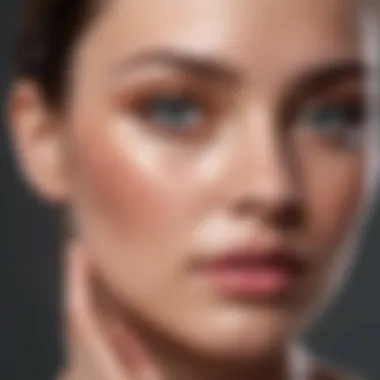Understanding Retinol and Retinoids: Key Differences


Intro
In the realm of skincare, the terms retinol and retinoid often surface, yet many do not fully understand what differentiates them. This lack of clarity is concerning, particularly as these two substances play pivotal roles in promoting skin health. Understanding their unique properties is vital for anyone looking to enhance their skincare routine effectively.
Retinol is a type of vitamin A that is widely regarded for its anti-aging properties. It is often found in over-the-counter products and is celebrated for its ability to accelerate cell turnover, improve skin texture, and reduce the appearance of fine lines.
On the other hand, retinoids represent a broader category of compounds that include both retinol and prescription-strength derivatives such as tretinoin. These formulations tend to be more potent and are typically advised for more severe skin issues, including acne or extensive sun damage.
The chemical structures of these compounds differ significantly, which in turn affects their efficacy and the skin's absorption levels. Understanding these differences is not merely academic; it can translate into practical advice for skin care choices tailored to individual needs.
The following sections will explore the fundamental distinctions between retinol and retinoids, the science behind their functionality, their benefits, potential side effects, and how to choose the appropriate product based on your skin type and concerns.
Preface to Retinol and Retinoids
The exploration of skincare ingredients has become increasingly relevant in today’s beauty landscape. Among the various compounds available, retinol and retinoids shine for their profound effects on skin health. Understanding these components is crucial for anyone looking to enhance their skincare routine.
Defining Retinol
Retinol is a potent derivative of vitamin A, often heralded for its ability to promote cellular turnover and enhance skin texture. It helps in reducing the appearance of fine lines, wrinkles, and blemishes, making it a staple in anti-aging skincare. Being available in both prescription and over-the-counter products, retinol caters to a wide range of skin types. Its relatively gentle nature allows users to incorporate it into their routines without significant discomfort, though some sensitivity may occur. Regular use can unveil smoother and brighter skin, illustrating retinol's popularity in modern cosmetics.
Defining Retinoids
Retinoids encompass a broader category that includes retinol and its more potent variants. These substances not only promote cell turnover but also work on a genetic level to influence the skin's structure and function. Prescription-based retinoids, such as tretinoin and adapalene, are typically stronger and may provide quicker results, but they often come with a higher risk of side effects. By understanding the definitions and distinctions between retinol and retinoids, one can make an informed decision about which product suits their skincare goals best.
In summary, defining these terms lays the groundwork for appreciating their significance in skincare. This understanding prompts a more informed decision-making process for consumers aiming to improve their skin health.
Chemical Composition and Structure
The chemical composition and structure of retinol and retinoids form a fundamental aspect of understanding their impact on the skin. Both compounds derive from vitamin A, yet the distinctions in their molecular structures contribute to substantial differences in efficacy and application. This section explores the specific elements, benefits, and considerations surrounding the chemical makeup of these ingredients.
Molecular Differences
Retinol, a form of vitamin A, has a specific molecular structure that allows it to convert into retinoic acid within the skin. Retinoids, on the other hand, encompass a broader category, including both prescription and over-the-counter formulations. The molecular variations between these compounds influence their gut absorption and skin efficacy.
Retinol molecules are less potent than those of prescription-strength retinoids, such as Tretinoin. This difference in molecular speed is also defining for skin application. Retinoids often provide results at a faster rate due to their configuration and immediate bioavailability.
Here are some distinct molecular characteristics:
- Retinol: Hydroxyl group present, making it sensitive to light and air, which affects stability.
- Retinoids like Tretinoin: More stable due to their chemical structure, leading to faster action on the skin.
Overall, understanding these molecular differences assists in selecting the right product.
Absorption Rates
Absorption rates of retinol and retinoids set the stage for their effectiveness on the skin. These rates are influenced by the molecular structure, formulations, and the skin barrier. Retinol must realistically convert to retinoic acid during absorption, which can limit efficacy.
In comparison, certain retinoids bypass this conversion. They enter the skin faster and work immediately, helping to tailor specific treatments.
Several factors influence absorption rates:
- Formulation: Creams, serums, gels - each having varied absorption levels.
- Skin Type: Oily or dry skin can enhance or impede absorption.
- Usage Method: Contact with moisture or layering followed by extracting can shift effectiveness.
Understanding absorption rates is crucial for optimizing results and minimizing irritation when using retinol and retinoids. As with any ingredient, consider how your skin reacts and absorbs different products.


"The efficiency of absorption is key to realizing the promised benefits of retinol and retinoids."
To summarize, chemical composition and structure are critical in determining the effectiveness of retinol and retinoids. Knowing how these differences influence treatment choices can guide you in achieving desired results in skincare.
Mechanism of Action
Understanding the mechanism of action is crucial when distinguishing between retinol and retinoids. Both of these compounds interact with skin in powerful ways, influencing various biological processes. This section aims to clarify how each substance operates at a cellular level, including relevant elements such as their efficacy, absorption, and overall benefits for skin health.
How Retinol Works on the Skin
Retinol is a derivative of vitamin A, known for its role in skin regeneration. When applied topically, retinol penetrates the skin and is metabolized into retinoic acid, the active form. This conversion occurs within the skin's layers and is essential for retinol's effectiveness.
Once retinol is converted, it stimulates collagen production, which helps to improve skin elasticity and reduces the appearance of fine lines. Additionally, it promotes cell turnover, which can lead to a more youthful complexion and a more even skin tone. This process encourages the shedding of dead skin cells and the formation of new ones, minimizing pores and targeting acne and pigmentation issues.
However, the speed and efficiency of this process can vary among individuals. Thus, users might need time to observe beneficial results. It is often advisable to introduce retinol gradually into one’s skincare routine to manage potential irritation.
How Retinoids Function
Retinoids, which include both prescription and over-the-counter options, work in a manner similar to retinol but with distinct differences in strength and effectiveness. These compounds also undergo conversion to retinoic acid, but they typically do so more effectively and rapidly than retinol. This means they may provide quicker results, making them preferred options for those with more severe skin concerns.
There are different types of retinoids, such as tretinoin and adapalene. Each has its unique properties, but they generally reduce inflammation, minimize acne breakouts, and improve skin texture. Retinoids can also influence gene expression in skin cells, promoting a more youthful appearance by repairing sun-damaged skin and accelerating cell replacement.
While the benefits of retinoids are substantial, they often carry a higher risk of side effects. Users may experience dryness, peeling, or redness, especially when starting treatment. Therefore, it is critical to follow a well-structured application strategy in consultation with a dermatologist.
"Both retinol and retinoids are significant for skin health, but understanding their mechanisms is essential for choosing the right treatment."
Benefits of Retinol and Retinoids
The benefits of retinol and retinoids are multifaceted, influencing various aspects of skin health. This section aims to elucidate the advantages these compounds provide. Understanding their benefits allows consumers to make informed choices tailored to their specific skin concerns. Both retinol and retinoids have become staples in skincare routines due to their proven effects.
Anti-Aging Properties
One of the principal advantages of retinol and retinoids is their anti-aging effects. These compounds promote collagen production, which is essential for maintaining skin elasticity. As one ages, collagen levels naturally decline, leading to wrinkles and sagging skin. Retinol and retinoids stimulate the skin's rejuvenation processes. In clinical studies, participants experienced noticeable reductions in fine lines and improved skin firmness after consistent use.
Additionally, these ingredients help with cellular turnover, bringing fresh skin cells to the surface. This results in a more youthful appearance, as dull skin cells are sloughed away. When considering products, it is essential to focus on formulations that feature stable retinol or potent retinoids for maximum anti-aging benefits.
"Skincare ingredients like retinol not only reduce existing fine lines but also prevent further signs of aging."
Acne Treatment Efficacy
Another significant benefit is the efficacy of retinol and retinoids in treating acne. They work by regulating oil production and preventing clogged pores, common triggers for acne breakouts. The anti-inflammatory properties further aid in reducing the redness that often accompanies acne lesions.
Studies indicate that retinoids can decrease the frequency and severity of acne flares, helping to maintain clearer skin over time. Individuals with persistent acne conditions might find prescription-strength retinoids, such as tretinoin, particularly beneficial. However, even lower-strength retinol can produce effective results with regular usage.
Improvement in Skin Texture
Retinol and retinoids contribute significantly to enhancing skin texture. By increasing cell turnover, these ingredients help diminish rough patches and uneven skin tone. Users often report smoother skin after a few weeks of consistent application. Retinol's ability to diminish hyperpigmentation is also noteworthy, allowing for a more even complexion. Various formulations are available, catering to both sensitive and resilient skin types.
Side Effects and Considerations
Understanding the side effects and considerations associated with retinol and retinoids is crucial for effective skincare. While both ingredients offer significant benefits, they can also cause adverse reactions, especially for certain skin types. This section aims to empower readers by providing insight into potential side effects, enabling them to make informed decisions regarding their skincare regimens.
Common Side Effects of Retinol


Retinol is often celebrated for its anti-aging effects but may bring about some unwanted side effects. The most prevalent side effects include:
- Skin Irritation: This can manifest as redness, peeling, or flaking, particularly during the initial weeks of use.
- Dryness: Users may experience excessive dryness and tightness as the skin undergoes a significant adjustment.
- Photosensitivity: Increased sensitivity to sunlight can occur, necessitating diligent use of sunscreen.
These side effects usually diminish with continued use as skin accommodates the ingredient. It is advisable to start with a lower concentration of retinol and gradually increase it as tolerance builds.
Possible Side Effects of Retinoids
Prescription retinoids tend to be more potent, which raises the risk of stronger side effects. Users might encounter:
- Severe Irritation: Similar to retinol, but may be more pronounced.
- Flushing: Some individuals report a temporary feeling of warmth or redness after application.
- Allergic Reactions: In rare instances, individuals may have allergic responses, including rash or hives.
- Purging: An increase in acne during the initial phase of use is common as blocked pores begin to clear.
Awareness of these potential side effects can help users manage expectations and prepare adequately.
Managing Skin Irritation
Mitigating skin irritation is essential for both retinol and retinoid users. Here are some strategies to reduce side effects:
- Start Slowly: Begin with lower concentrations and less frequent applications to allow skin adaptation.
- Moisturize: Use a gentle, hydrating moisturizer to combat dryness and irritation. This can also help soothe the skin post-application.
- Sun Protection: Apply broad-spectrum sunscreen daily to protect sensitive skin from UV damage and further irritation.
- Consult Professionals: Dermatologists can provide tailored advice and adjustments to regimens and may recommend alternative products suitable for sensitive skin.
By understanding these side effects and managing them effectively, users can maximize the benefits of retinol and retinoids while minimizing discomfort.
Choosing Between Retinol and Retinoids
When it comes to selecting the most suitable skincare product between retinol and retinoids, several critical considerations come into play. Knowing the differences can ease the decision-making process, ensuring that individuals find the right fit for their unique skin needs.
Identifying Skin Types and Concerns
First and foremost, understanding your skin type is fundamental to making an informed choice. Different skin types—oily, dry, combination, and sensitive—have distinctive needs. For instance, individuals with oily skin may benefit more from retinoids, which have a stronger potency and can help in managing acne. If you have dry or sensitive skin, retinol might be a more appropriate option due to its milder effects.
Additionally, skin concerns vary greatly: some may aim for anti-aging benefits, while others seek to treat acne or improve overall texture. It is essential to consider these goals. For example, someone targeting fine lines may find retinoids advantageous due to their enhanced efficacy in promoting cell turnover. However, a person with reactive skin might experience irritation with such strong formulations and should gravitate toward retinol. Knowing your skin type and concerns ultimately guides the decision, ensuring the chosen product aligns with your individual skincare needs.
Product Potency and Concentration
The potency of a product can significantly influence its effects on the skin. Retinoids typically come in prescription-strength forms, offering higher concentrations that yield quicker results. However, with greater potency may come an increased risk of side effects, which is an important factor for potential users to consider.
In contrast, retinol is readily available over-the-counter and often comes in lower concentrations. Users may find retinol easier to incorporate into a routine, especially if they are new to retinoids.
Here are some key points to consider:
- Strength: Retinoids are stronger, possibly providing noticeable results faster.
- Testing the Waters: If new to retinoids, starting with retinol can help acclimate your skin, allowing you to assess tolerance.
- Long-Term Use: Both retinol and retinoids can be effective when used consistently, but the strength may lead to differences in how often one can apply the product before irritation occurs.
Ultimately, the right choice hinges on personal comfort and the specific results one hopes to achieve. With careful thought into skin type, concerns, and desired potency, individuals can navigate the landscape of skincare products harmoniously and effectively.
Choosing the appropriate skincare ingredient is not just about effectiveness, but understanding how it integrates with your unique skin profile.
Dispelling Myths and Misconceptions
Addressing myths and misconceptions surrounding retinol and retinoids is crucial for readers to fully understand these skincare components. Misinterpretations can lead to improper usage, ultimately hindering the desired results and possibly causing adverse effects. An informed approach ensures that users make educated choices that align with their skin care needs.
Retinol is Always Gentler
A common belief is that retinol is always a gentler option compared to prescription retinoids. This assumption may not hold true in all cases. While it is correct that retinol is often considered less potent, individual skin reactions can vary significantly. Some may find retinol irritates their skin, making it less suitable.


Additionally, formulations of retinol can vary in concentration. Products marketed as gentle may still contain effective doses. Therefore, users could experience irritation from potent retinol products just as they might from certain prescriptive retinoids. It’s essential to evaluate products on a case-by-case basis rather than relying solely on brand claims or general assumptions.
Skin sensitivity varies widely. What is gentle for one person may not be for another.
All Retinoids are Prescription Only
Another pervasive myth is the belief that all retinoids require a prescription. While some retinoids, such as tretinoin, are indeed available only through prescription, others can be found in over-the-counter formulations. Products containing adapalene, for instance, are now available without needing a doctor's approval in many markets.
Furthermore, the availability of different retinoids means users can find suitable options that cater to their skin's requirements, even without a prescription. This accessibility allows for a broader selection of products tailored to various concerns, such as aging and acne, making it easier for consumers to find effective solutions. Understanding these distinctions encourages proper product selection without unnecessary confusion.
Application Techniques and Timing
When discussing retinol and retinoids, understanding the proper application techniques and timing is crucial. These practices directly impact the effectiveness of the products and can help minimize potential side effects. Knowing how to incorporate these ingredients into your skincare routine can maximize their benefits and ensure healthy skin.
When to Apply Retinol/Retinoids
Choosing the right time to apply retinol or retinoids can affect your results. Experts typically recommend applying these products in the evening. This is because they can increase sun sensitivity, which makes daytime application less desirable. Applying them at night allows the skin to undergo its natural repair processes without interference from UV rays.
It is also important to cleanse your face before application. This prepares the skin and removes any barriers that might interfere with absorption. After cleansing, wait a few minutes to ensure the skin is completely dry. Applying retinol or retinoids on damp skin can lead to irritation as they penetrate deeper.
Start with a smaller amount. A pea-sized amount for the entire face is sufficient. This helps to gauge how your skin reacts before increasing the amount. If you are just beginning, using retinol or retinoids 2-3 times a week can help your skin adapt. Gradually increasing the frequency can reduce irritation.
Layering with Other Products
Layering retinol or retinoids with other skincare products is an important consideration. The order of application can significantly impact results. Generally, a good rule of thumb is to apply thinner textures to thicker ones. Retinol is often applied after cleansing but before heavier creams or oils.
When layering:
- Cleanser - Start with a gentle cleanser to avoid stripping the skin.
- Toner (optional) - This can help to balance the skin's pH.
- Serum - If using serums, apply them next. Choose ones that do not contain strong active ingredients to avoid irritation.
- Retinol/Retinoid - This should be applied next. Allow it to absorb for a few minutes.
- Moisturizer - Finish with a moisturizer to lock in hydration and further reduce the risk of irritation.
While layering, avoid combining retinol or retinoids with other potent actives like vitamin C or AHAs/BHAs. Doing so may enhance irritation and sensitivity. Monitor your skin's response and adjust your routine accordingly.
Consistency is key. Regular application maximizes the benefits, while proper timing and layering reduces the risk of adverse reactions.
Ending
In understanding the distinctions between retinol and retinoids, it becomes clear that both ingredients play crucial roles in skincare, yet they serve different needs and preferences. This article aims to elucidate these differences, emphasizing the importance of selecting the right product according to individual skin types and concerns.
Summarizing Key Differences
Retinol and retinoids vary in terms of formulation, strength, and application.
- Strength: Retinoids, particularly prescription versions like Tretinoin, are typically more potent than over-the-counter retinol.
- Use and Accessibility: Retinol is more commonly found in skincare products accessible without prescription, whereas retinoids often require a healthcare provider's consent.
- Effects on Skin: While both can aid in improving skin texture, reducing fine lines, and combating acne, retinoids tend to deliver faster results due to their higher concentration.
Overall, consumers must consider their skin's sensitivity, desired results, and any potential side effects when choosing between the two.
Final Recommendations
For those new to retinol or retinoids, it is advisable to start with lower concentrations, particularly in retinol products, to gauge skin sensitivity. Gradual introduction can prevent unnecessary irritation.
For specific skin concerns:
- Acne: Prescription retinoids like Adapalene may be preferred for treating moderate to severe acne.
- Aging: If combating aging signs, retinol may be sufficient for those with milder concerns, while stronger retinoids might be better for deeper wrinkles.
General Advice:
- Always apply these products in the evening, following proper cleansing.
- Pair them with a good moisturizer to mitigate dryness or irritation.
- Always use sunscreen during the day, as these ingredients can increase sun sensitivity.
By understanding the nuances of these skincare components, individuals are better equipped to make informed choices, ensuring their skincare regime aligns with their unique needs.







